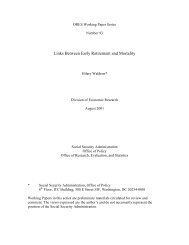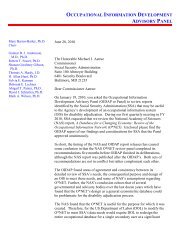are similar to each other and are more similar to theoccupational distribution of those without a disabilitythan the working SSI occupational distribution.SSI recipients are more common in certain occupations:production (16 percent), transportation andmaterial moving (15 percent), and buildings andgrounds cleaning and maintenance (15 percent).Service, production, and transportation and materialmoving occupations account for almost two-thirdsof SSI employment. Many SSI recipients also workin office and administrative support occupations(13 percent), although they are only slightly less likelyto work in these occupations than the other groups.The most common occupational groups of each of theother populations are office and administrative support,sales and related occupations, and construction,extraction, maintenance, and repair.These results are similar to the occupational distributionsfound by Hale, Hayghe, and McNeil (1998).Although they used different occupational groupings,they found that those with severe disabilitieswere most likely to work in service occupations andas operators, fabricators, and laborers, followed byadministrative support, including clerical occupations.McNeil (1993, as cited in Stoddard and others (1998))found that 5 of the top 10 occupations of individualswith disabilities were employed as machine operators,food preparation and services, sales, cleaningor building services, and as motor vehicle operators,which are among the most common occupations forpeople with disabilities in the distributions estimatedabove. Both of those studies used the SIPP to estimateoccupation distributions. The occupational distributionof SSI recipients is also similar to estimates from theNational Beneficiary Survey of the occupations of SSIrecipients and DI beneficiaries who work. Thorntonand others (2008) show that the most common occupationsof working SSI recipients and DI beneficiariesare in transportation and material moving (22 percent),production (14 percent), and building or groundscleaning and maintenance (13 percent). 17Table 2 presents the Herfindahl-Hirschman andoccupational dissimilarity indices for each of thepopulation groups. The SSI population has the mostconcentrated occupational distribution (1,090). Aswould be expected, nonrecipients without disabilitieshave the lowest HHI (775). The HHI of the nonrecipientpopulations with a disability or work disability areslightly higher (796 and 786, respectively).Although there is a high degree of similaritybetween the occupation rankings of the groups, thereis also significant dissimilarity. Comparing workingSSI recipients to the population without disabilities,37 percent of the population would have to changeoccupation to achieve parity. This is higher than thepercent that would need to change occupations whenSSI recipients are compared with the populations withany disability (29 percent) or a work disability (26 percent).The occupational distribution of those with awork-related disability and any disability are quiteTable 2.Herfindahl-Hirschman and occupational dissimilarity indices of the employed populationEmployed populationSSI recipientsNon-SSI recipients with—No disability Any disability Work disabilityPanel A: Herfindahl-Hirschman indexPopulation 1,089.90 774.93 795.82 786.49Panel B: Dissimilarity indexSSI recipients 0.00 36.95 29.23 26.49Non-SSI recipientsNo disability . . . 0.00 10.23 12.85Any disability . . . . . . 0.00 3.77Work disability . . . . . . . . . 0.00SOURCE: Author's calculations using the 2007 American Community Survey using balanced repeated replicate sample weights.NOTES: The dissimilarity indices are calculated between the actual distributions. The dissimilarity matrix is symmetrical and only half ispresented. This is the proportion of the two groups that would need to change occupations for there to be parity between the occupationaldistributions of the two groups.The sum of individual categories may not equal the total because of rounding.. . . = not applicable.54 <strong>Social</strong> <strong>Security</strong> Bulletin • Vol. 69 • No. 3 • 2009
similar, only 4 percent of the population would need tochange occupations for parity, and only 10–13 percentof the population would need to change occupations toequalize their distributions with respect to the populationwithout a disability. Note that Table 2, panel B issymmetric and only one-half is presented.Predicted DistributionsWhether or not the differences between these distributionsdisappear once factors such as age and educationare taken into consideration would be useful forplanning vocational rehabilitation or other back-toworkincentives. To do this, separate multinomial logitmodels of occupational choice are estimated for thefour populations. The models control for sex, race,ethnicity, marital status, age, and education. Disabilitytype is included in all but the no-disability model.Four separate sets of occupational distributions arethen predicted for each group based on the coefficientsfor each of these models, as described earlier.The predicted occupations of the working SSIpopulation based on these models are presented inTable 3; those of the population with disabilities arepresented in Table 4; those of the population withoutdisabilities are presented in Table 5; and those withwork disabilities are presented in Table 6. Thesepredicted occupational distributions are compared withthe actual distribution for each group in Table 1. InTable 3, for example, the coefficients of the four occupational-choicemodels are applied to the working SSITable 3.Estimated occupational distributions of the employed SSI population, by occupational-choice model aOccupationSSI recipientsNon-SSI recipients with—No disability Any disability Work disabilityTotal 100.00 100.00 100.00 100.00Management, professional, and related 9.25 16.64 13.38 12.92Management 1.70 6.37 4.17 4.18Business and financial operations 1.48 2.53 1.84 1.78Computer and mathematical, architecture andengineering, life, physical and social science 0.25 2.38 2.00 1.71Community and social services 1.60 0.82 1.07 1.03Legal 0.33 0.49 0.44 0.42Education, training, and library 2.02 2.43 2.28 2.10Arts, design, entertainment, sports, and media 1.06 1.23 1.15 1.14Health-care practitioner and technical 1.07 2.77 2.42 2.29Service 33.60 21.88 28.99 30.00Health-care support 1.72 3.03 3.53 3.34Protective service 1.31 2.01 2.10 2.15Food preparation and serving related 9.75 7.47 9.62 9.98Building and grounds cleaning and maintenance 14.54 5.29 8.74 9.33Personal care and service 6.27 4.08 5.00 5.20Sales and office 21.71 27.36 24.58 22.49Sales and related 8.66 11.18 10.43 10.30Office and administrative support 13.05 16.18 14.15 13.98Farming, fishing, and forestry 0.84 0.72 0.77 0.72Construction, extraction, maintenance, and repair 3.90 12.59 10.22 10.10Production, transportation, and material moving 30.45 18.45 20.05 22.49Production 15.68 9.55 9.48 9.09Transportation and material moving 14.78 8.90 10.57 11.18SOURCE: Author's calculations using the 2007 American Community Survey.NOTES: The sum of individual categories may not equal the total because of rounding.a. The occupational-choice models are based on separate multinomial logit regressions of occupation for each population group.Covariates in all models include sex, ethnicity, race, marital status, education, age, and age squared. The disabled, work-disabled, andworking-SSI models also include disability type as additional covariates. All estimates use ACS balanced repeated replicate sampleweights. See Table A-3 for the results of the models.<strong>Social</strong> <strong>Security</strong> Bulletin • Vol. 69 • No. 3 • 2009 55
- Page 1 and 2:
Social SecuritySocial SecurityBulle
- Page 3:
Social SecurityBulletin Vol. 69, No
- Page 6 and 7:
Perspectives77 An Empirical Study o
- Page 8 and 9:
Selected Abbreviations—continuedM
- Page 10: within the next few years (Aglira 2
- Page 14 and 15: coverage varies significantly by ra
- Page 16 and 17: non-Hispanic white, and college edu
- Page 18 and 19: same groups (Table 6). For the last
- Page 20 and 21: from DB to DC pensions is accelerat
- Page 22 and 23: Table 8.Percent of individuals who
- Page 24 and 25: not necessarily the largest gains a
- Page 26 and 27: shoring-up DB plans before those pl
- Page 28 and 29: Table B-1.Percent change in mean pe
- Page 30 and 31: Table B-3.Percent of individuals wh
- Page 32 and 33: ReferencesAaronson, Stephanie, and
- Page 35 and 36: Social Security Administration’s
- Page 37: Chart 1.Historical expansion of Soc
- Page 40 and 41: self-employment information for the
- Page 42 and 43: (Cronin 1985). The final earnings r
- Page 44 and 45: prior to 1950, first year of earnin
- Page 46 and 47: average indexed monthly earnings (A
- Page 48 and 49: 13For an explanation of how the sel
- Page 50 and 51: Kopczuk, Emmanuel Saez, and Jae Son
- Page 53 and 54: Occupations of SSI Recipients Who W
- Page 55 and 56: on the differences between the occu
- Page 57 and 58: prediction models. Table A-1 lists
- Page 59: Occupational Distributions of theEm
- Page 63 and 64: Table 5.Estimated occupational dist
- Page 65 and 66: Table 7.Predicted Herfindahl-Hirsch
- Page 67 and 68: Table 9.Estimated occupational dist
- Page 69 and 70: Table 11.Average annual wages of wo
- Page 71 and 72: Table A-2.Means and standard errors
- Page 73 and 74: Table A-3.Coefficients and standard
- Page 75 and 76: Table A-3.Coefficients and standard
- Page 77 and 78: Table A-3.Coefficients and standard
- Page 79 and 80: management, professional, and relat
- Page 81: Stapleton, David C., Nanette Goodma
- Page 84 and 85: Selected Abbreviations—continuedO
- Page 86 and 87: The 1983 Amendments to the Social S
- Page 88 and 89: Chart 1.Proportion of new claimants
- Page 90 and 91: Table 4.The evolution of the ARF an
- Page 92 and 93: for the test of equality of means b
- Page 94 and 95: Table 8.Average monthly Social Secu
- Page 96 and 97: in the chart, especially for men, t
- Page 98 and 99: 6This is a very important character
- Page 100 and 101: Benítez-Silva, Hugo, Berna Demiral
- Page 103 and 104: OASDI and SSI Snapshot andSSI Month
- Page 105 and 106: Monthly Statistical Snapshot, Augus
- Page 107 and 108: Table 2.Recipients, by eligibility
- Page 109 and 110: SSI Federally Administered Payments
- Page 111 and 112:
Table 7.Average monthly payment, by
- Page 113:
Awards of SSI Federally Administere
- Page 116 and 117:
Copyright—Authors are responsible
- Page 119 and 120:
Program Highlights, 2009Old-Age, Su








